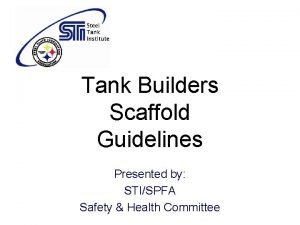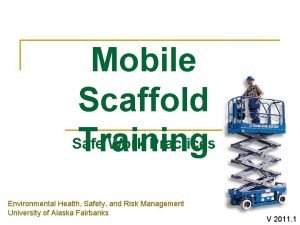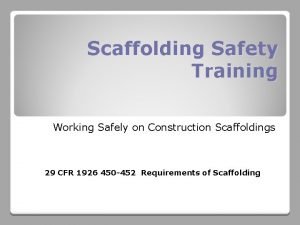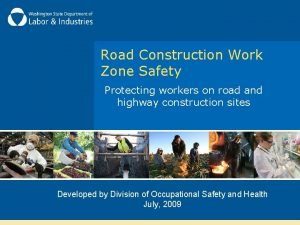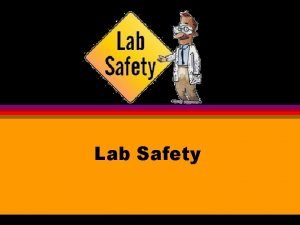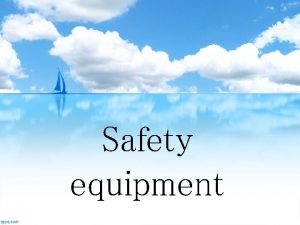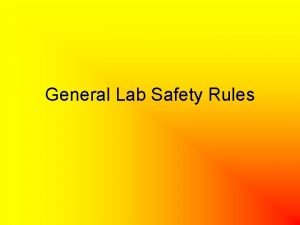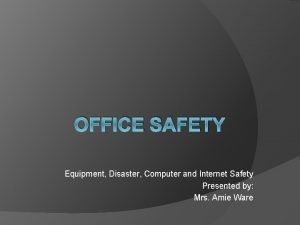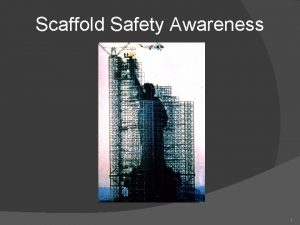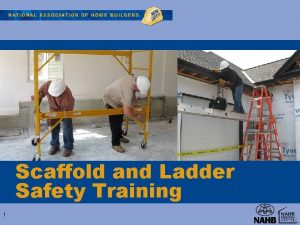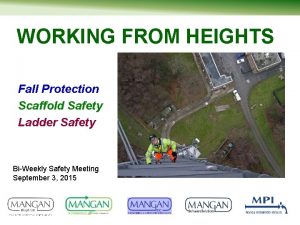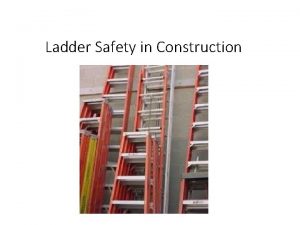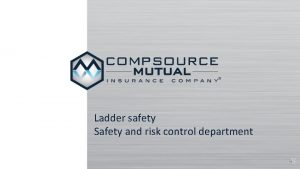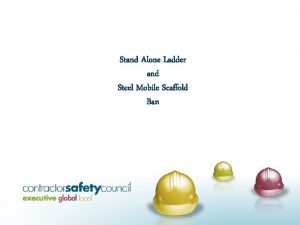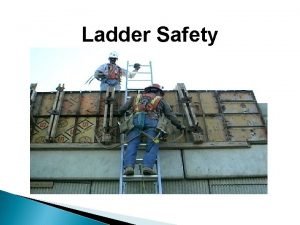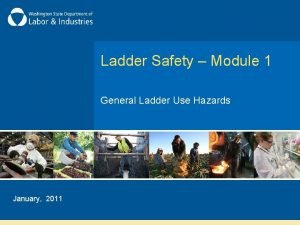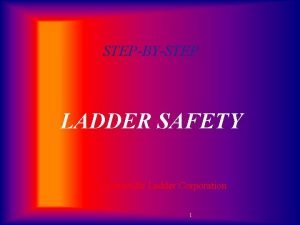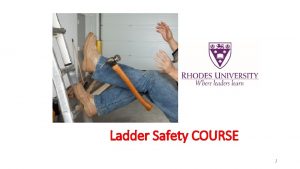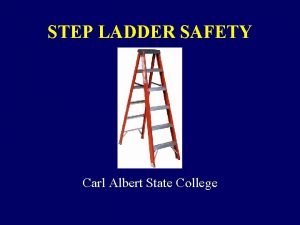Ladder Safety Choosing Right Equipment Ladder or Scaffold










































- Slides: 42

Ladder Safety


Choosing Right Equipment -- Ladder or Scaffold? • Will the job take only a short amount of time? • Does work require sideto-side movement? • Does the work require using tools with both hands? Ladder Scaffold

Types of Ladders • • • Straight Ladder Step Ladder Extension Ladder • • • Sectional Ladder Trestle Ladder Trolley Ladder Side Rolling Mason’s Ladder • • • Max 30’ Max 20’ Max 60’ • Combined lengths of section not longer than specified for equivalent non- sectional types • • Max 30’ Max 20’ Max 40’

Advantages/Disadvantages of: • Fiberglass – Strong, lightweight, electrically nonconductive – More expensive than wood or metal

Advantages/Disadvantages of: • Metal – Must not be used when working on or near electrical wires – lightweight

Advantages/Disadvantages of: • Wood – Heavier than aluminum or fiberglass – Can rot – Electrically non-conductive

Extension Ladders • Always raise extension ladders so that the upper section overlaps and rests on the bottom section. • The upper section must always overlap on the climbing side of the extension ladder.

Straight Ladder • If a straight ladder is used to climb onto an elevated work station, it will extend at least 3 1/2 feet above the working level. This ladder is not sufficiently extended

Load Limits -- Step Ladders • Select a ladder designed to hold the necessary load, including worker and equipment: – Type I -- industrial stepladder for heavy duty, such as utilities, contractors and industrial use – Type II -- commercial stepladder for medium duty, painters office, light industrial (not recommended at UWM) – Type III -- Household (not allowed at UWM)

• Review checklist prior to using ladder

Immediately remove ladder from service if inspection finds: • Broken or missing steps, rungs or cleats • Broken or damaged side rails • Other faulty equipment such as missing feet, damaged connections, broken rivets

• Always place ladders on a stable surface • Clear debris • Level uneven ground

• Base of straight ladder should be 1 foot away from the surface for every 4 feet to the top (1: 4) 4 feet 1 foot

• Always assure secure footing • Keep ladder free from mud, grease and other substances which could cause you to slip • Keep area around ladder free from traffic.

• Always lock or guard door if ladder blocks doorway

• Face the ladder when ascending or descending • Both hands should be placed on ladder rails, not on rungs, when ascending and descending • Maintain 3 point contact at all times -- This means both feet and one hand or one foot and both hands

• Use extra caution while climbing in windy weather

• Always climb completely past the landing before stepping over

• Don’t “walk” a ladder (rocking from side to move) • Don’t use a stepladder as a straight ladder

• Don’t carry tools in your hands. (A tool pouch or belt should be used or tools should be hoisted up) • Don’t overreach to either side or lean too far forward or backward

• Don’t use a ladder without locking spreader or other device in place

• Don’t climb using bracing on back legs of step ladder • Don’t attempt to straighten or use a bent ladder made of metal or reinforced plastic--repairs should be made by qualified personnel

• Don’t Climb using two highest steps or top of platform

• Don’t use a defective ladder • Don’t block a fire exit • Don’t use a ladder as a platform • Don’t use a ladder by more than one person

• Don’t place ladder on boxes, barrels or other unstable surfaces to extend height

• Don’t use a ladder if you are feeling dizzy, light-headed, are excessively tired, on medication, have recently consumed alcohol or are otherwise temporarily impaired.

• Store ladders for easy access and inspection. • Store vertically if possible. If not possible, store horizontally supporting ladder at several points to avoid sagging • Protect ladder from heat, weather and corrosive materials

• Do not leave ladders where they may create a tripping or fall hazard for others

• Lift ladder using legs muscles, not back • Carry holding ladder close to body

When carrying ladder: • Balance center of ladder on your shoulder • Position so front end of ladder is above your head and back end is near the ground

When ascending and descending stairs, carry ladder with one hand hold stair rail with the other hand

• Set ladder down when opening and closing doors • Take special care when negotiating corners or turning around

• When it is necessary for two people to carry a ladder, both should be on the same side of ladder and both people should walk in step. • Spikes, hooks or ladder feet should face toward the rear when ladder is being carried

• Always face ladder when ascending, descending and performing work

• Keep between the side rails when working --your body should be centered on the ladder so your belt buckle is between the side rails

• When replacing lights, never touch both connections of fixture at the same time

What’s Wrong in this Picture?

What’s Wrong in this Picture?

What’s Wrong in this Picture?

What’s Wrong in this Picture?

• What’s Wrong in this Picture?
 Right product right place right time right price
Right product right place right time right price Right time right place right quantity right quality
Right time right place right quantity right quality The right man on the right place at the right time
The right man on the right place at the right time Basic cooking techniques
Basic cooking techniques 6 choose the correct answers.
6 choose the correct answers. Vocab workshop level g unit 12
Vocab workshop level g unit 12 Apa itu layout lokasi
Apa itu layout lokasi Scaffold trailer for sale
Scaffold trailer for sale Tank scaffolding support
Tank scaffolding support Each platform must be fully planked
Each platform must be fully planked Why does dimmesdale go to the scaffold
Why does dimmesdale go to the scaffold Bridle scaffolding
Bridle scaffolding Mobile scaffold accident
Mobile scaffold accident Nasc tg20:13 free download
Nasc tg20:13 free download Bridge overhang scaffold
Bridge overhang scaffold Drupal 8 composer
Drupal 8 composer Child and adolescent development and facilitating learning
Child and adolescent development and facilitating learning Sample business report hsc
Sample business report hsc Cariotipo del maiz
Cariotipo del maiz Feature article scaffold
Feature article scaffold Petal scaffold
Petal scaffold Txxxc paragraph structure example
Txxxc paragraph structure example Statue of liberty scaffold
Statue of liberty scaffold Double flying shore
Double flying shore Science greatly advanced when galileo favored
Science greatly advanced when galileo favored Bioresorbable vascular scaffold
Bioresorbable vascular scaffold Types of scaffolding ppt
Types of scaffolding ppt Scaffold terminology
Scaffold terminology Pump jack scaffold must be fitted with two
Pump jack scaffold must be fitted with two A brick falls freely from a high scaffold
A brick falls freely from a high scaffold Science safety equipment
Science safety equipment Science safety equipment
Science safety equipment Heavy equipment safety poster
Heavy equipment safety poster Ppe for plumbers
Ppe for plumbers Poem about impulse and momentum
Poem about impulse and momentum Safety symbols in lab
Safety symbols in lab Alabama boat requirements
Alabama boat requirements Slobo risancic
Slobo risancic Dress code safety rules
Dress code safety rules Computer safety equipment
Computer safety equipment Lab safety quiz
Lab safety quiz Heavy equipment checklist
Heavy equipment checklist Jeopardy lab
Jeopardy lab








